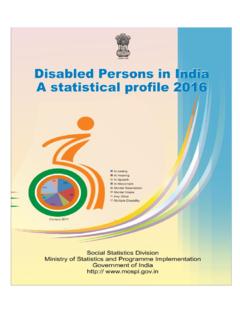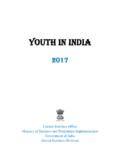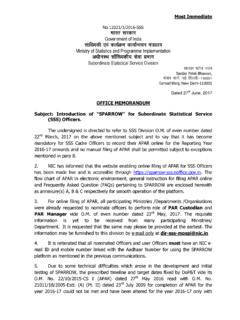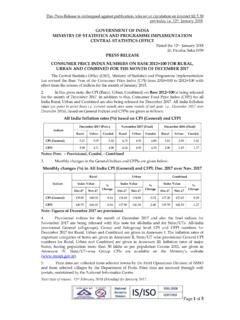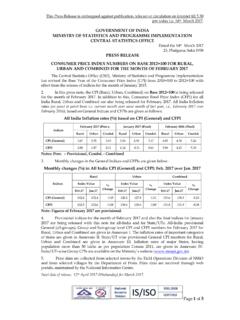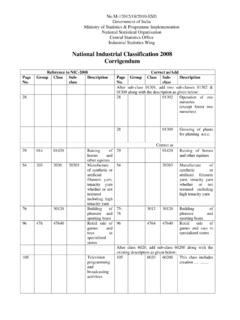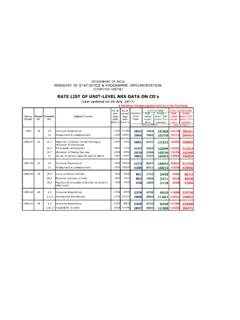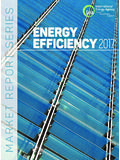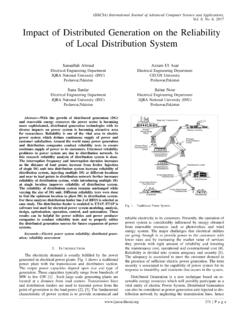Transcription of Energy Statistics - mospi.nic.in
1 Energy Statistics 2018 Energy Statistics 2018 (Twenty Fifth Issue) CENTRAL Statistics OFFICE MINISTRY OF Statistics AND PROGRAMME IMPLEMENTATION GOVERNMENT OF INDIA NEW DELHI CENTRAL Statistics OFFICE Energy Statistics 2018 FOREWORD Energy is one of the most important building blocks in human development, and as such, acts as a key factor in determining the economic development of all the countries. In an effort to meet the demands of a developing nation, the Energy sector has witnessed a rapid growth. It is important to note that non-renewable resources are significantly depleted by human use, whereas renewable resources are produced by ongoing processes that can sustain indefinite human exploitation. The use of renewable resources of Energy is rapidly increasing worldwide. Solar power, one of the potential Energy sources, is a fast developing industry in India.
2 The country's solar installed capacity has reached GW in year 2016-17 as compared to GW during the year 2015-16. India has expanded its solar generation capacity by GW during last one year which has led to downward trend in the cost and has increased usage. It clearly signifies that proper integration of policy interventions holds the key to achieve the sustainable development goals. This publication, 25th in the series is an annual publication of CSO and is a continued effort to provide a comprehensive picture of Energy Sector in India. Energy Statistics is an integrated and updated database of reserves, installed capacity, production, consumption, import, export and whole sale prices of different sources viz. coal, crude petroleum, natural gas and electricity. Energy Balance and Sankey Diagram ( Energy flow diagram) adds analytic value and thus increases its utility.
3 Energy indicators are being brought out by CSO as part of Energy Statistics for the use of policy makers as well as for comprehensive reporting. Indicators play a vital role by turning data into information for policy makers and help in decision-making. Keeping in view the importance of Energy Goal no 7 of Sustainable Development Goals, Double the global rate of improvement in Energy efficiency has been accounted in the form of an indicator Energy intensity measured in terms of primary Energy and GDP . Disaggregation of the indicator Energy Intensity at sectoral level Industry, agriculture and transport is also available in the publication. Identification of list of indicators depends on various factors as transparency, scientific validity, robustness, sensitivity and the extent to which they are linkable to each other.
4 However no single factor can decide all indicators and all situations since each indicator needs different data sets. The indicators are selected on the guidelines/approach followed by IAEA in their publication Energy Indicators for Sustainable Development: Guidelines and Methodologies , which was brought out in corporation with United Nations Department of Economic and Social Affairs (UNDESA), International Energy Agency (IEA), Eurostat and European Environmental Agency (EEA). The data in the publication has been sourced from the subject Ministries of the Government of India. The co-operation and support provided by these Ministries/Departments in compiling this publication is appreciated. I also appreciate the efforts of the officers of Economic Statistics Division, Central Statistics Office in bringing out this publication in a time bound manner.
5 I hope the publication will prove to be useful to the policy makers, planners and researchers working in field of Energy . It shall be CSO s endeavour to continuously improve the publication both in content and design with the help of user feedback and data source agencies. March 2018 Ranganadham New Delhi DIRECTOR GENERAL, CSO CENTRAL Statistics OFFICE Energy Statistics 2018 CONTENTS PAGE Energy Maps of India i Map 1: Wind Power Potential at 100m agl i Metadata- Energy Statistics ii-iv Highlights of Energy Statistics 2016-17 v chapter 1 : Reserves and Potential for Generation 1-7 Highlights 1-4 Table : State-wise Estimated Reserves of Coal 5 Table (A): State-wise Estimated Reserves of Lignite 5 Table :State-wise Estimated Reserves of Crude Oil and Natural Gas 6 Table : Source wise and State wise Estimated Potential of Renewable Power 7 chapter 2 : Installed Capacity and Capacity Utilization 8-20 Highlights 8-11 Table : Installed Capacity of Coal Washeries in India 12-13 Table : Installed Capacity and Capacity Utilization of Refineries of Crude Oil 14 Table.
6 Installed Generation Capacity of Electricity in Utilities and Non Utilities 15 Table : Regionwise and State wise Installed Generating Capacity of Electricit y(Ut ilit ies) 16 Table : State wise and Source wise Total Installed Capacity of Grid Interactive Renewable Power 17-18 Table : Installed of Off-grid/ Decentralised Renewable Energy Systems/ Devices 19-20 chapter 3: Production of Commercial Sources of Energy 21-29 Highlights 21-23 Table : Production of Primary Sources of Conventional Energy 24 Table : Production of Energy (in Peta Joules) by Primary Sources 24 Table : Production of Coal and Lignite 25-26 Table : Domestic Production of Petroleum Products 27 Table : Gross and Net Production of Natural Gas 28 Table : Gross Generation of Electricity in Utilities and Non-utilit ies 28-29 chapter 4 : Foreign Trade in Commercial Sources Of Energy 30-32 Highlights 30-31 Table : Foreign Trade in Coal, Crude Oil, Petroleum Products and Electricity in India 32 chapter 5 : Availability o f Energy Sources 33-36 Highlights 33-34 Table : Availability of Primary Sources of Conventional Energy 35 Table : Availability of Raw Coal and Lignite for Consumption 35 Table : Availability of Crude Oil, Petroleum Products and natural gas 36 Table : Availabilit y o f Electricit y 36 CENTRAL Statistics OFFICE Energy Statistics 2018 PAGE chapter 6 :Consumption Of Energy Resources 37-52 Highlights 37-42 Table : Consumption of Conventional Sources of Energy 43 Table : Growth in Energy Consumption and Energy intensity 44 Table : Consumption of Conventional Energy ( Peta Joules) 44 Table : Industry wise Consumption of Raw Coal 45 Table.
7 Industry wise Consumption of Lignite 45 Table : Consumption of Petroleum Products 46 Table : Sector-wise(end use) Consumption of Selected Petroleum Products 47-50 Table : Industry-wise Off-take of Natural Gas 50-51 Table : Consumption of Electricity (from utilities) by Sectors 51 Table : Electricity Generated(from Utilities), Distributed, Sold and Lost 52 chapter 7 : Energy Balance 53-59 Highlights 53-55 Table : Energy Commodity Balance 56 Table : Energy Balance 57 chapter 8 : Wholesale Price Index of Energy Commodities 60-62 Highlights 60-61 Table : Wholesale Price Indices of Energy Commodities 62 chapter 9 : World Production and Consumption of Crude Oil & Natural Gas 63-73 Highlights 63-65 Table : Country wise Estimates of Production of Crude Oil 66-67 Table : Country-wise Estimates of Consumption of Crude Oil 68-69 Table : Country-wise Estimates of Production of Natural Gas 70-71 Table : Country-wise Estimates of Consumption of Natural Gas 72-73 chapter 10 : Energy Indicators 74-81 Highlights 74-80 Table: : List of Energy Indicators 81 Annexures to Metadata 82-101 Annex I :Definitions adopted by United Nations and India 82-88 Annex II :Conversion Factors 89 Annex III :Abbreviations 90 Annex IV:Categorisation of Coal in India 91 Annex V : Energy Data Collection Mechanisms-Country Practice 92-101 CENTRAL Statistics OFFICE Energy Statistics 2018 Energy MAPS OF INDIA Map: Wind Power Potential at 100m agl (2016-17) Source: Ministry of New and Renewable Energy i CENTRAL Statistics OFFICE i Energy Statistics 2018 METADATA- Energy Statistics 1.
8 Contact Contact organisation Central Statistics Office(CSO), Ministry of Statistics & Programme Implementation (MOSPI) Contact organisation unit Economic Statistics Division, CSO Contact mail address Level 4, East Block 6, R. K. Puram, New Delhi 110066. Contact emails Homepage http:// 2. Statistical presentation Data sources The data contained in this publication has been sourced from the Ministry of Petroleum and Natural Gas, Central Electricity Authority, Office of Coal Controller, Ministry of New and Renewable Energy Office of the Economic Advisor, Ministry of Commerce and Industry and National Accounts Division, Ministry of Statistics and Programme Implementation. Data description The Statistics present information about the reserves, installed capacity, potential for generation, production, consumption, import, export, wholesale price of different Energy commodities and Energy Indicators on economic dimension.
9 Sector coverage Coal & Lignite, Petroleum & Natural Gas, Renewable Energy Resources and Electricity.(Data collection Mechanism is given in Annex:V.). The indicators are based on the guidelines/approach followed by IAEA in their publication Energy Indicators for Sustainable Development: Guidelines and Methodologies , which was brought out in corporation with United Nations Department of Economic and Social Affairs (UNDESA), International Energy Agency (IEA), Eurostat and European Environmental Agency (EEA). Also, the choice of indicators was made as per the availability of data from the subject ministries. Data content The Statistics are given by type of fuel and Energy source. The publication includes analytical indicators viz. Growth Rates, Compound Annual Growth Rates (CAGR), Percentage Distributions and Economics Energy Indicators. Statistical unit Data are aggregated appropriately at national and state level.
10 Statistical population Data covers all the Energy commodity sources. Reference area The Energy industries of the entire country are covered. Time coverage In the current publication the data given is for the period 2006-07 to 2015-16 and is based on Statistics compiled by the Ministry of Petroleum and Natural Gas, Central Electricity Authority, Office of Coal Controller, Ministry of New and Renewable Energy . The data for Office of the Economic Advisor, Ministry of Commerce and Industry and National Accounts Division has been sourced for the year 2011-12 to 2016-17. Energy Indicators on Economic Dimension have compiled for the year 2016-17 Base period ii CENTRAL Statistics OFFICE ii Energy Statistics 2018 Base year 2011-12 for WPI and GDP data. Statistical concepts and definitions The main Concepts and Definitions are given in Annex: I. (Annex: II & Annex: III respectively give certain Conversion Factors and Abbreviations used along with the method of estimation used for estimating midyear population figures) Annex IV gives categorization of coal in IndiaAnnex V gives details of definitions and concepts of Economic Energy Indicators.
